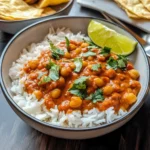It was one of those whirlwind weeks – work deadlines piling up, school events for the kids, and a general feeling of “what on earth am I going to make for dinner?” lingering in the air. I craved something comforting, something that felt like a warm hug in a bowl, but also something relatively healthy and not too complicated. That’s when Chickpea Tikka Masala came to the rescue. I’d made chicken tikka masala countless times, a certified family favorite, but I wanted a plant-based version that didn’t skimp on flavor or satisfaction. Skepticism was high in my household; could chickpeas really replace the tender chicken we were used to in this iconic dish? The answer, as we discovered, was a resounding YES! The aroma that filled the kitchen as the spices bloomed and the sauce simmered was intoxicating. The chickpeas, tender and slightly nutty, soaked up the rich, creamy, tomato-based sauce beautifully. Served over fluffy basmati rice with a side of warm naan, it was an absolute triumph. My eldest, usually a staunch meat-lover, went back for seconds, declaring it “surprisingly amazing.” My partner loved the depth of flavor and how satisfying it was without feeling heavy. It has since become a regular in our meal rotation, a go-to for a delicious, wholesome, and incredibly flavorful weeknight dinner that everyone genuinely looks forward to. This Chickpea Tikka Masala isn’t just a recipe; it’s a testament to how plant-based cooking can be utterly delicious and deeply satisfying.
Ingredients
Here’s what you’ll need to create this vibrant and flavorful Chickpea Tikka Masala:
- For the Chickpeas & Marinade (Optional but Recommended):
- 2 (15-ounce) cans chickpeas (garbanzo beans): Rinsed and drained thoroughly. These are the stars of our dish, providing protein and a wonderful texture.
- 1 tablespoon lemon juice: Freshly squeezed is best, for a bright, zesty tang.
- 1 teaspoon garam masala: A complex Indian spice blend that adds warmth and depth.
- ½ teaspoon ground cumin: For an earthy, warm flavor.
- ½ teaspoon turmeric powder: Adds a beautiful golden color and mild, earthy notes.
- Pinch of salt: To enhance the flavors.
- For the Tikka Masala Sauce:
- 1 tablespoon coconut oil or vegetable oil: For sautéing the aromatics. Coconut oil adds a subtle sweetness, but any neutral oil works.
- 1 large yellow onion: Finely chopped. This forms the sweet and savory base of our sauce.
- 3-4 cloves garlic: Minced. A crucial aromatic for depth of flavor.
- 1-inch piece of fresh ginger: Peeled and grated or minced. Adds a warm, zesty kick.
- 1 green bell pepper (optional): Chopped. Adds a slight crunch and fresh flavor; red or yellow bell pepper works too.
- 1 jalapeño or serrano chili (optional): Finely minced, seeds removed for less heat. Adjust to your spice preference.
- 1 tablespoon tomato paste: For concentrated tomato flavor and rich color.
- 1 ½ teaspoons garam masala: The signature spice blend for Tikka Masala.
- 1 teaspoon ground coriander: Adds a citrusy, earthy note.
- 1 teaspoon ground cumin: Reinforces the earthy warmth.
- ½ teaspoon turmeric powder: For color and its characteristic flavor.
- ¼ – ½ teaspoon cayenne pepper or red chili powder (optional): Adjust to your desired heat level.
- 1 (28-ounce) can crushed tomatoes or tomato purée: The heart of the sauce, providing tanginess and body.
- 1 (13.5-ounce) can full-fat coconut milk: This is key for the creamy texture and rich flavor. Shake well before opening. For a lighter version, light coconut milk can be used, but it will be less creamy.
- 1 teaspoon sugar or maple syrup (optional): To balance the acidity of the tomatoes.
- Salt and freshly ground black pepper: To taste. Season generously.
- Juice of ½ lemon: Added at the end for brightness.
- Fresh cilantro (coriander leaves): Chopped, for garnish. Adds a burst of freshness.
Instructions
Follow these steps to create your delicious homemade Chickpea Tikka Masala:
- Prepare the Chickpeas (Optional Marination): If you have a little extra time, this step enhances the flavor of the chickpeas. In a medium bowl, combine the rinsed and drained chickpeas, 1 tablespoon lemon juice, 1 teaspoon garam masala, ½ teaspoon ground cumin, ½ teaspoon turmeric powder, and a pinch of salt. Toss gently to coat. Set aside for at least 15-20 minutes, or while you prepare the sauce ingredients. If skipping this step, simply have your rinsed and drained chickpeas ready.
- Sauté Aromatics: Heat the coconut oil or vegetable oil in a large, heavy-bottomed pot or Dutch oven over medium heat. Once the oil is shimmering, add the finely chopped onion and cook, stirring occasionally, for 5-7 minutes, or until softened and translucent. Don’t rush this step; well-cooked onions build a fantastic flavor base.
- Add Ginger, Garlic, and Chili: Add the minced garlic, grated ginger, and optional minced jalapeño (if using) to the pot. Sauté for another 1-2 minutes until fragrant. Be careful not to burn the garlic, as it can become bitter. The aroma at this stage should be wonderfully inviting.
- Incorporate Bell Pepper (if using) and Tomato Paste: If you’re using bell pepper, add it now and cook for 3-4 minutes until it starts to soften. Then, stir in the tomato paste and cook for 1-2 minutes, stirring constantly. Cooking the tomato paste briefly helps to deepen its flavor and remove any metallic taste.
- Bloom the Spices: Add the 1 ½ teaspoons garam masala, ground coriander, ground cumin, ½ teaspoon turmeric powder, and optional cayenne pepper to the pot. Stir well and cook for about 1 minute, until the spices are fragrant. This step, known as “blooming” the spices, is crucial for releasing their full aromatic potential. The mixture will become quite thick and paste-like.
- Build the Sauce Base: Pour in the can of crushed tomatoes (or tomato purée). Stir everything together, scraping up any browned bits from the bottom of the pot – these are packed with flavor! Bring the mixture to a gentle simmer.
- Simmer the Sauce: Reduce the heat to low, cover the pot, and let the sauce simmer for at least 10-15 minutes. This allows the flavors to meld and deepen. The longer it simmers (within reason, up to 30 minutes on very low heat), the more developed the taste will be. Stir occasionally to prevent sticking.
- Add Coconut Milk and Chickpeas: Uncover the pot and stir in the full-fat coconut milk until well combined. The sauce will transform into a beautiful, creamy orange-pink hue. Add the marinated chickpeas (or plain rinsed and drained chickpeas) to the sauce. Stir gently to incorporate.
- Continue Simmering: Bring the curry back to a gentle simmer (do not boil vigorously, especially with coconut milk, as it can sometimes curdle if boiled too hard). Cook, uncovered, for another 10-15 minutes, or until the chickpeas are heated through and the sauce has thickened to your desired consistency. Stir occasionally.
- Balance and Finish: Taste the sauce. Stir in the optional sugar or maple syrup if you feel it needs a touch of sweetness to balance the tomato acidity. Season generously with salt and freshly ground black pepper to your liking. Finally, stir in the juice of ½ lemon for a final burst of brightness. This really lifts all the flavors.
- Garnish and Serve: Ladle the Chickpea Tikka Masala into bowls. Garnish generously with freshly chopped cilantro. Serve hot with your favorite accompaniments (see “How to Serve” section below).
Nutrition Facts
- Servings: This recipe makes approximately 4-6 servings.
- Calories per serving (approximate): 450-550 calories (this can vary based on exact ingredients like the fat content of coconut milk and serving size).
- Protein: Rich in plant-based protein primarily from the chickpeas, essential for muscle repair and satiety. A serving provides a significant portion of your daily protein needs.
- Fiber: High in dietary fiber, also thanks to the chickpeas and vegetables. Fiber aids digestion, helps regulate blood sugar, and promotes a feeling of fullness.
- Healthy Fats: Contains healthy fats from the coconut milk (primarily medium-chain triglycerides if using full-fat) and cooking oil, which are important for hormone production and nutrient absorption.
- Vitamin C: Good source of Vitamin C from the tomatoes, bell peppers (if used), and lemon juice, which supports immune function and acts as an antioxidant.
- Iron: Chickpeas provide a decent amount of iron, crucial for oxygen transport in the blood and preventing fatigue.
Preparation Time
- Preparation Time (Chopping & Marinating): Approximately 15-20 minutes (if marinating chickpeas, this includes their resting time). If not marinating, prep time is closer to 10-15 minutes for chopping vegetables.
- Cooking Time: Approximately 30-40 minutes (including simmering time for the sauce and chickpeas).
- Total Time: Approximately 45-60 minutes from start to finish, making it a manageable and incredibly rewarding meal for a weeknight or a relaxed weekend.
How to Serve
Chickpea Tikka Masala is wonderfully versatile and pairs beautifully with a variety of accompaniments. Here are some classic and creative ways to serve it:
- Grains:
- Basmati Rice: The most traditional pairing. The fluffy, fragrant grains of basmati rice are perfect for soaking up the rich, creamy sauce. Plain steamed basmati is classic, or try it with a sprinkle of toasted cumin seeds (Jeera Rice).
- Brown Rice: For a healthier, whole-grain option, brown rice works well and adds a nuttier flavor and chewier texture.
- Quinoa: Another excellent healthy alternative, quinoa provides complete protein and has a delightful texture that complements the curry.
- Cauliflower Rice: For a low-carb, grain-free option, serve over steamed or lightly sautéed cauliflower rice.
- Breads:
- Naan Bread: Warm, soft naan bread is almost essential for scooping up every last bit of the delicious sauce. Plain, garlic, or butter naan are all fantastic choices. You can find pre-made naan in most supermarkets or try making your own.
- Roti or Chapati: These whole wheat flatbreads are a lighter alternative to naan and are equally good for mopping up the curry.
- Pita Bread: If naan or roti isn’t available, warm pita bread can also work well.
- Side Dishes & Condiments:
- Cucumber Raita: A cooling yogurt-based side dish made with grated cucumber, mint, and sometimes a pinch of roasted cumin. It provides a refreshing contrast to the warmth of the curry. For a vegan version, use plain unsweetened plant-based yogurt.
- Kachumber Salad: A simple Indian salad made with chopped cucumbers, tomatoes, onions, and a lemon-cilantro dressing. It adds freshness and crunch.
- Plain Yogurt or Coconut Yogurt: A dollop of plain dairy or non-dairy yogurt on top can add extra creaminess and a cooling element.
- Mango Chutney: The sweetness and tanginess of mango chutney complement the savory and spicy notes of the Tikka Masala beautifully.
- Lime or Lemon Wedges: A squeeze of fresh lime or lemon juice just before eating brightens up all the flavors.
- Garnishes:
- Fresh Cilantro (Coriander Leaves): A generous sprinkle of chopped fresh cilantro is a must for its fresh, herbaceous flavor and vibrant green color.
- Toasted Sliced Almonds or Cashews: For a bit of crunch and nutty flavor.
- A swirl of Coconut Cream: For an extra touch of richness and visual appeal, drizzle a little extra coconut cream on top just before serving.
- Thinly Sliced Red Onion or Pickled Onions: Adds a pungent bite and visual contrast.
Additional Tips
Make your Chickpea Tikka Masala even better with these handy tips:
- Adjust Spice Level: This recipe is moderately spiced. To make it milder, omit the jalapeño and cayenne pepper entirely. For a spicier kick, keep the seeds in the jalapeño, add more cayenne, or even a pinch of a hotter chili powder like Kashmiri red chili powder (which also adds great color).
- For Creamier Sauce: Ensure you’re using full-fat coconut milk. For an ultra-creamy version, you can stir in a tablespoon or two of cashew cream (soaked cashews blended with a little water) or a dollop of coconut cream at the end of cooking.
- Sneak in More Veggies: Feel free to add other vegetables along with the bell pepper. Good additions include chopped spinach or kale (stirred in during the last 5-10 minutes of simmering until wilted), peas (frozen peas can be added in the last 5 minutes), diced carrots or sweet potatoes (add them with the onions as they take longer to cook).
- Use Fresh Spices: The quality and freshness of your spices make a huge difference. Ground spices lose their potency over time. If your spices have been sitting in the cupboard for years, consider replacing them for the best flavor.
- Make it Ahead: Tikka Masala, like many curries, often tastes even better the next day as the flavors have more time to meld. Prepare it a day in advance, let it cool completely, and store it in an airtight container in the refrigerator. Reheat gently on the stovetop or in the microwave.
- Don’t Overcook the Chickpeas: Canned chickpeas are already cooked. You’re essentially just heating them through and allowing them to absorb the sauce flavors. Overcooking can make them mushy.
- Freezing Instructions: This Chickpea Tikka Masala freezes beautifully. Allow it to cool completely, then transfer it to freezer-safe containers or heavy-duty freezer bags. It can be frozen for up to 3 months. Thaw overnight in the refrigerator and reheat gently on the stovetop, adding a splash of water or coconut milk if needed to adjust consistency.
- Taste and Adjust Seasoning: This is perhaps the most crucial tip for any recipe. Before serving, always taste your curry. Does it need more salt? A bit more lemon juice for brightness? A pinch more sugar to balance acidity? A touch more spice? Adjust accordingly to suit your personal preference.
FAQ Section
Here are answers to some frequently asked questions about Chickpea Tikka Masala:
- Q: Can I make this recipe vegan?
- A: Yes, absolutely! This recipe as written is inherently vegan, provided you use coconut oil or vegetable oil (not ghee) and ensure your sugar (if using) is vegan-certified (as some white sugar is processed with bone char). The creaminess comes from full-fat coconut milk. If serving with yogurt, use a plant-based alternative.
- Q: What’s the difference between Chickpea Tikka Masala and Chana Masala?
- A: While both are popular Indian chickpea curries, they have distinct flavor profiles. Chana Masala typically has a more tangy and robustly spiced flavor, often featuring amchur (dried mango powder) and a darker, less creamy sauce. Tikka Masala is known for its creamy, mildly spiced, tomato-based sauce, often sweeter and richer due to the addition of cream or coconut milk.
- Q: Can I use dried chickpeas instead of canned?
- A: Yes, you can. You’ll need to soak about 1 cup of dried chickpeas overnight, then cook them until tender before adding them to the sauce. This usually involves boiling them for 1-2 hours or pressure cooking them. One cup of dried chickpeas yields roughly 3 cups of cooked chickpeas, which is equivalent to about two 15-ounce cans.
- Q: I don’t have all the individual spices. Can I use a pre-made curry powder?
- A: While garam masala is quite specific to Tikka Masala, if you’re in a pinch, you could substitute a good quality mild curry powder for the combination of cumin, coriander, and turmeric. However, try to use garam masala if possible, as it’s key to the signature flavor. You might need to adjust the amount of curry powder used.
- Q: How long will Chickpea Tikka Masala last in the refrigerator?
- A: Stored in an airtight container, it will last for 3-4 days in the refrigerator. In fact, the flavors often develop and taste even better on the second or third day.
- Q: My sauce is too thin. How can I thicken it?
- A: You can simmer it uncovered for a little longer to allow some of the liquid to evaporate. Alternatively, you can make a slurry by mixing 1 tablespoon of cornstarch or arrowroot powder with 2 tablespoons of cold water, then stir it into the simmering sauce and cook for a minute or two until thickened. Another option is to mash some of the chickpeas against the side of the pot to release their starch.
- Q: Can I make this recipe oil-free?
- A: Yes, you can make an oil-free version. Sauté the onions, garlic, and ginger in a little water or vegetable broth instead of oil. You may need to add a tablespoon or two at a time to prevent sticking. The final dish might be slightly less rich, but still delicious.
- Q: Is Chickpea Tikka Masala healthy?
- A: Generally, yes! It’s packed with plant-based protein and fiber from chickpeas, and vitamins from the tomatoes and spices. Using full-fat coconut milk adds saturated fat, so if you’re watching your fat intake, you could opt for light coconut milk (though the sauce will be less creamy) or use it in moderation. Overall, it’s a nutritious and satisfying meal, especially when paired with whole grains.

Chickpea Tikka Masala
- Total Time: 1 hour
Ingredients
Here’s what you’ll need to create this vibrant and flavorful Chickpea Tikka Masala:
- For the Chickpeas & Marinade (Optional but Recommended):
- 2 (15-ounce) cans chickpeas (garbanzo beans): Rinsed and drained thoroughly. These are the stars of our dish, providing protein and a wonderful texture.
- 1 tablespoon lemon juice: Freshly squeezed is best, for a bright, zesty tang.
- 1 teaspoon garam masala: A complex Indian spice blend that adds warmth and depth.
- ½ teaspoon ground cumin: For an earthy, warm flavor.
- ½ teaspoon turmeric powder: Adds a beautiful golden color and mild, earthy notes.
- Pinch of salt: To enhance the flavors.
- For the Tikka Masala Sauce:
- 1 tablespoon coconut oil or vegetable oil: For sautéing the aromatics. Coconut oil adds a subtle sweetness, but any neutral oil works.
- 1 large yellow onion: Finely chopped. This forms the sweet and savory base of our sauce.
- 3–4 cloves garlic: Minced. A crucial aromatic for depth of flavor.
- 1-inch piece of fresh ginger: Peeled and grated or minced. Adds a warm, zesty kick.
- 1 green bell pepper (optional): Chopped. Adds a slight crunch and fresh flavor; red or yellow bell pepper works too.
- 1 jalapeño or serrano chili (optional): Finely minced, seeds removed for less heat. Adjust to your spice preference.
- 1 tablespoon tomato paste: For concentrated tomato flavor and rich color.
- 1 ½ teaspoons garam masala: The signature spice blend for Tikka Masala.
- 1 teaspoon ground coriander: Adds a citrusy, earthy note.
- 1 teaspoon ground cumin: Reinforces the earthy warmth.
- ½ teaspoon turmeric powder: For color and its characteristic flavor.
- ¼ – ½ teaspoon cayenne pepper or red chili powder (optional): Adjust to your desired heat level.
- 1 (28-ounce) can crushed tomatoes or tomato purée: The heart of the sauce, providing tanginess and body.
- 1 (13.5-ounce) can full-fat coconut milk: This is key for the creamy texture and rich flavor. Shake well before opening. For a lighter version, light coconut milk can be used, but it will be less creamy.
- 1 teaspoon sugar or maple syrup (optional): To balance the acidity of the tomatoes.
- Salt and freshly ground black pepper: To taste. Season generously.
- Juice of ½ lemon: Added at the end for brightness.
- Fresh cilantro (coriander leaves): Chopped, for garnish. Adds a burst of freshness.
Instructions
Follow these steps to create your delicious homemade Chickpea Tikka Masala:
- Prepare the Chickpeas (Optional Marination): If you have a little extra time, this step enhances the flavor of the chickpeas. In a medium bowl, combine the rinsed and drained chickpeas, 1 tablespoon lemon juice, 1 teaspoon garam masala, ½ teaspoon ground cumin, ½ teaspoon turmeric powder, and a pinch of salt. Toss gently to coat. Set aside for at least 15-20 minutes, or while you prepare the sauce ingredients. If skipping this step, simply have your rinsed and drained chickpeas ready.
- Sauté Aromatics: Heat the coconut oil or vegetable oil in a large, heavy-bottomed pot or Dutch oven over medium heat. Once the oil is shimmering, add the finely chopped onion and cook, stirring occasionally, for 5-7 minutes, or until softened and translucent. Don’t rush this step; well-cooked onions build a fantastic flavor base.
- Add Ginger, Garlic, and Chili: Add the minced garlic, grated ginger, and optional minced jalapeño (if using) to the pot. Sauté for another 1-2 minutes until fragrant. Be careful not to burn the garlic, as it can become bitter. The aroma at this stage should be wonderfully inviting.
- Incorporate Bell Pepper (if using) and Tomato Paste: If you’re using bell pepper, add it now and cook for 3-4 minutes until it starts to soften. Then, stir in the tomato paste and cook for 1-2 minutes, stirring constantly. Cooking the tomato paste briefly helps to deepen its flavor and remove any metallic taste.
- Bloom the Spices: Add the 1 ½ teaspoons garam masala, ground coriander, ground cumin, ½ teaspoon turmeric powder, and optional cayenne pepper to the pot. Stir well and cook for about 1 minute, until the spices are fragrant. This step, known as “blooming” the spices, is crucial for releasing their full aromatic potential. The mixture will become quite thick and paste-like.
- Build the Sauce Base: Pour in the can of crushed tomatoes (or tomato purée). Stir everything together, scraping up any browned bits from the bottom of the pot – these are packed with flavor! Bring the mixture to a gentle simmer.
- Simmer the Sauce: Reduce the heat to low, cover the pot, and let the sauce simmer for at least 10-15 minutes. This allows the flavors to meld and deepen. The longer it simmers (within reason, up to 30 minutes on very low heat), the more developed the taste will be. Stir occasionally to prevent sticking.
- Add Coconut Milk and Chickpeas: Uncover the pot and stir in the full-fat coconut milk until well combined. The sauce will transform into a beautiful, creamy orange-pink hue. Add the marinated chickpeas (or plain rinsed and drained chickpeas) to the sauce. Stir gently to incorporate.
- Continue Simmering: Bring the curry back to a gentle simmer (do not boil vigorously, especially with coconut milk, as it can sometimes curdle if boiled too hard). Cook, uncovered, for another 10-15 minutes, or until the chickpeas are heated through and the sauce has thickened to your desired consistency. Stir occasionally.
- Balance and Finish: Taste the sauce. Stir in the optional sugar or maple syrup if you feel it needs a touch of sweetness to balance the tomato acidity. Season generously with salt and freshly ground black pepper to your liking. Finally, stir in the juice of ½ lemon for a final burst of brightness. This really lifts all the flavors.
- Garnish and Serve: Ladle the Chickpea Tikka Masala into bowls. Garnish generously with freshly chopped cilantro. Serve hot with your favorite accompaniments (see “How to Serve” section below).
- Prep Time: 20 minutes
- Cook Time: 40 minutes
Nutrition
- Serving Size: one normal portion
- Calories: 550






